In a hyper-competitive digital landscape, customer expectations are rising fast. Users demand personalized, seamless experiences—whether on a website, mobile app, or smart device. They want these interactions to be instantly tailored to their needs and consistent across every touchpoint, pushing brands to adopt more agile, modular digital strategies to keep up.
Traditional monolithic Digital Experience Platforms (DXPs) struggle to keep pace with the evolving needs of businesses. They are inflexible, slow to adapt, and burdened with excessive complexity. What if you could:
- Swap out a component in days instead of months?
- Scale your experience to new channels without rebuilding from scratch?
- Rapidly test and iterate on your digital presence?
Welcome to the world of Composable DXPs: modular, API-first, and agile. In this post, we’ll explore how the composable approach revolutionizes digital experience creation, especially when powered by Adobe’s ecosystem of solutions.
1. The Monolith vs. The Composable Model
Digital Experience Platforms (DXPs) are evolving. While monolithic DXPs offer an all-in-one solution, they often limit agility and flexibility. Composable DXPs, by contrast, break functionality into modular, best-of-breed components—enabling faster innovation, flexible scaling, and seamless integration through APIs. Here’s how they differ and why it matters.
1.1 What Is a Monolithic DXP?
Picture an all-in-one, tightly integrated suite:
- It manages your website, mobile apps, content, commerce, analytics, and personalization.
- Everything is consolidated under one umbrella and often relies on a single underlying infrastructure.
Pros:
- Simplified vendor management
- Unified roadmap
Cons:
- Releases are slow
- Upgrades are painful
- Innovations are bottlenecked
1.2 What Makes a DXP “Composable”?
At its core, Composable DXP embraces:
- Modularity: Each capability—content management, commerce, analytics—is a separate building block.
- API-First Approach: These blocks communicate via open RESTful or GraphQL APIs.
- Best-of-Breed Components: Pick and choose the best solution for each capability domain.
- Agile CD Pipelines: Deploy changes fast, test frequently, and iterate continuously.
Takeaway: You dismantle the monolith into reusable, flexible services. It’s like trading a jumbo jet for drones—smaller, smarter, and more agile.
Read More-: From Chaos to Clarity: Optimizing Marketing Operations with Adobe Workfront and AI
2. Why Brands Are Betting on Composable
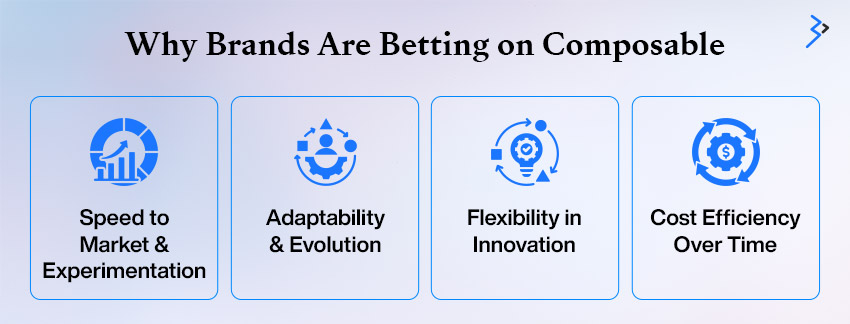
In this digital world, brands need agility, flexibility, and efficiency. Composable architecture empowers teams to launch faster, adapt quickly, and innovate freely—without the need to rebuild entire systems. From rapid experimentation to cost control, it’s a future-ready approach that meets evolving customer expectations and business demands head-on.
2.1 Speed to Market & Experimentation
Consumer expectations shift by the minute. Want to A/B test a personalized banner on your site? With composable, you can.
Modular systems let you:
- Integrate best-of-breed apps (e.g., headless CMS for content, third-party personalization engine).
- Launch new experiences using micro-frontends and APIs.
- Run experiments quickly and independently.
2.2 Adaptability & Evolution
Want to integrate with a new CRM or add augmented reality previews? No need to overhaul your entire stack. Just swap or plug in a new microservice.

2.3 Flexibility in Innovation
Composable lets you explore:
- Headless setups: decoupled content and presentation layers
- Multi-cloud deployments: safeguard against vendor lock-in
- Composable UX: micro frontends that deliver distinct pieces of functionality
2.4 Cost Efficiency Over Time
Though modularity may imply more vendors and integrations, budget control comes from:
- Replacing components independently
- Paying only for needed functionalities
- Avoiding platform-wide upgrades
3. Adobe’s Composable Stack: A Winning Combination
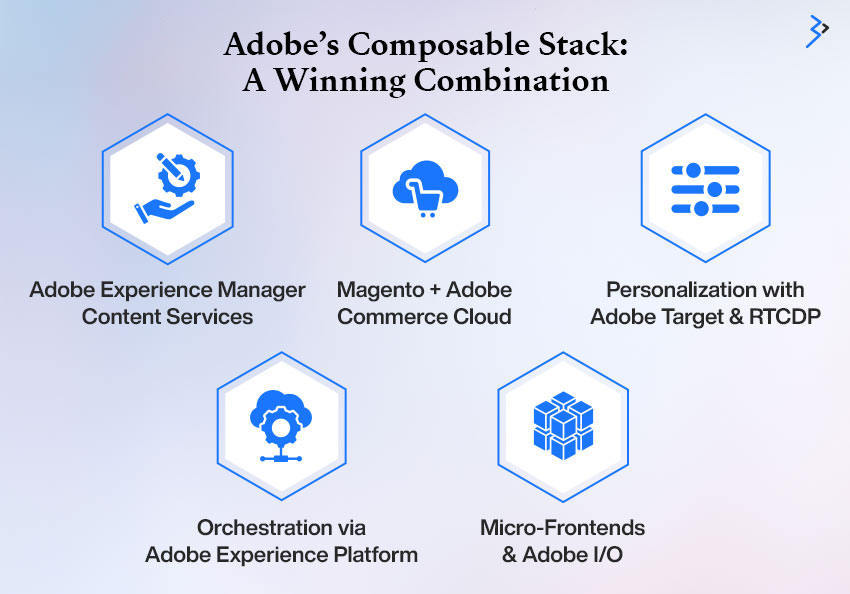
Adobe has reinvented its suite to embrace composability—a shift recognized in industry reports and customer outcomes.
3.1 Headless CMS: Adobe Experience Manager (AEM) Content Services
AEM Content Services delivers content via REST/GraphQL to any channel. That includes:
- SPAs built with React or Vue.
- Backend-less mobile apps.
- IoT and digital signage.
That flexibility enables truly omnichannel content delivery.
3.2 Commerce Essentials: Magento + Adobe Commerce Cloud
Adobe offers Magento (self-managed) and Commerce Cloud (SaaS). Both feature robust APIs, enabling:
- Headless commerce storefronts
- Integration with custom search or personalization providers
- Lightweight microservices for cart, checkout, and payment flows
3.3 Personalization with Adobe Target & RTCDP
Adobe Target uses behavior-driven AI, while Adobe Real-Time CDP unifies user data profiles:
- Centralizes profiles across web, mobile, CRM, etc.
- Enables real-time segmentation and activation (e.g., email, push)
- Synchronizes with Target, Analytics, and 3rd-party systems
3.4 Orchestration via Adobe Experience Platform (AEP)
AEP acts as the brain—centered data hub, governance layer, and composable event processor:
- Clean, govern, and unify data from multiple sources
- Apply decision-making and segment logic
- Distribute to channels and other Adobe services
3.5 Frontend Agility: Micro‑Frontends & Adobe I/O
With Adobe I/O, you can:
- Build decoupled UIs using micro-frontends
- Trigger serverless functions and event slots via I/O Runtime
- Simplify third-party integration through secure API management
Read More – Scaling Your eCommerce Business Effectively with Adobe Commerce on AACS
4. Real-World Use Cases
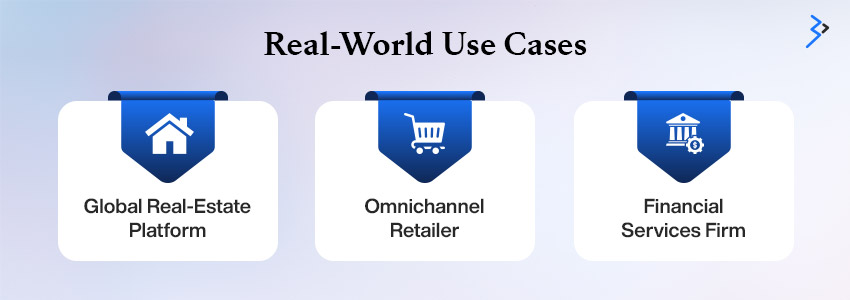
4.1 Global Real‑Estate Platform
A prominent global real-estate brand struggled with poor web performance, sluggish localization processes, and a rigid content delivery structure. These limitations affected both user experience and market adaptability. To address this, the brand transitioned to:
- AEM headless CMS for flexible content delivery across multiple channels
- Static-site generator (SSG) frontend to improve load times and deliver a blazing-fast experience
- Third-party map APIs to enhance listing interactivity with real-time geolocation and neighborhood data
Results:
- 75% faster page loads, significantly improving SEO rankings and reducing bounce rates
- Introduction of pluggable modules enabled the integration of immersive virtual tours and 3D walkthroughs, transforming how users explore properties
- Localized websites could now be launched in a few hours instead of weeks, allowing faster market entry and improved regional engagement
4.2 Omnichannel Retailer
A well-known apparel retailer aimed to unify its digital presence across platforms while enhancing customer engagement. The strategy included:
- Headless commerce with Magento for agile, scalable product management
- Adobe Experience Manager to power dynamic editorial content and marketing campaigns
- Third-party personalization engine to tailor experiences based on real-time user behavior
- Mobile app built in React Native to deliver a consistent cross-platform shopping experience
Benefits:
- Seamless integration allowed a consistent product catalog and editorial storytelling across web and mobile
- Achieved a 30% uplift in conversions through intelligent, data-driven product recommendations
- Gained agility to pilot new payment methods—including Apple Pay, Binance Pay, and Buy Now, Pay Later (BNPL)—without backend overhauls
4.3 Financial Services Firm
A leading financial services firm requires a robust platform to deliver personalized, real-time dashboards to clients across devices. The solution stack included:
- Adobe Experience Platform (AEP) for unified customer profiles and data intelligence
- AEM for delivering compliant, modular financial content
- Adobe Target to automate investment recommendations
- Microservices architecture to dynamically deliver financial tools like investment calculators
Outcomes:
- Achieved a 40% increase in self-service interactions, reducing dependency on support agents
- Enabled faster compliance updates by editing modular content without redeploying entire pages
- Allowed for the independent deployment of new financial tools, accelerating innovation and client satisfaction
Read More – Transforming Customer Service: Proactive and Personalized Support with Adobe Journey Optimizer
5. Implementation Guide: How to Build a Composable DXP with Adobe
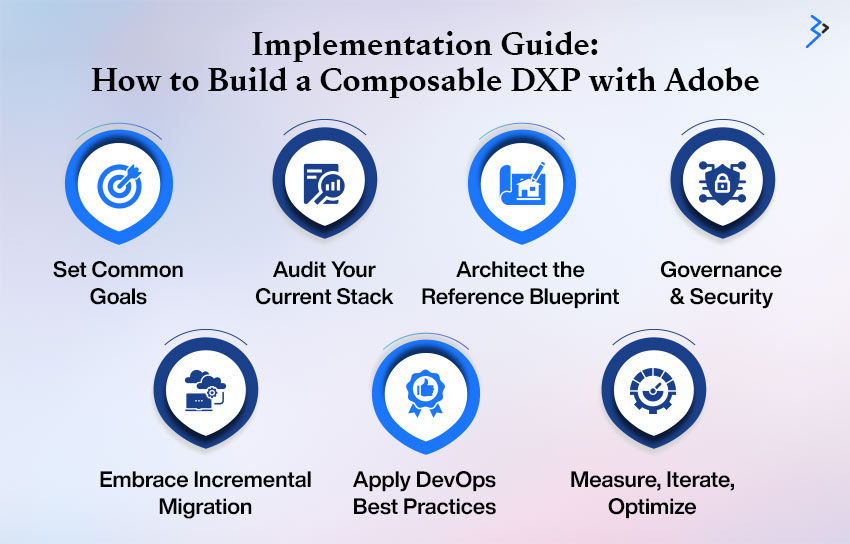
5.1 Set Common Goals
Start by aligning business and tech teams around shared objectives:
- Define target channels: web, mobile, kiosks, AR, and more
- Establish KPIs: page load speed, user engagement, conversion rates
- Plan for scale: expected traffic volumes, seasonal peaks, and geographic distribution
5.2 Audit Your Current Stack
Know where you stand before building forward:
- List all key components: CMS, commerce, analytics, CDP, personalization engines
- Identify integration points and assess API-readiness
- Run a performance audit to detect slow-loading areas and architectural bottlenecks
5.3 Architect the Reference Blueprint
Design a modular and scalable future state:
- Break systems into reusable building blocks
- Define clean API contract layers for inter-service communication
- Use event-driven architecture for extensibility and real-time interactions
- Plan infrastructure with containerization (Docker) and infrastructure-as-code (IaC) principles
5.4 Embrace Incremental Migration
Roll out changes with confidence and control:
- Start with a headless CMS like AEM for one key experience
- Migrate the commerce storefront next and sync with personalized user profiles
- Build using micro-frontends for modular development and faster releases
- Integrate Adobe Target and AEP for real-time personalization and decision-making
- Track performance; expand based on real-world success metrics
5.5 Apply DevOps Best Practices
Ensure speed, stability, and scalability with modern DevOps workflows:
- Containerize each service with Docker
- Orchestrate deployments using Kubernetes
- Set up CI/CD pipelines per module for continuous releases
- Include API contract testing, performance benchmarking, and rollback capabilities
- Monitor with Real User Monitoring (RUM) and synthetic testing tools
5.6 Governance & Security
Protect your platform and customer data at every layer:
- Use Adobe Experience Platform for role-based access and governance
- Apply API rate limiting using Adobe I/O to prevent abuse
- Secure the frontend with OAuth and JWT authentication protocols
5.7 Measure, Iterate, Optimize
Refinement is ongoing—make your platform smarter over time:
- Leverage Adobe Analytics Services and AEP to track KPIs and user journeys
- Optimize search, content, and personalization strategies based on insights
- Continuously test new ideas with A/B and multivariate experiments
- Scale horizontally and adjust infrastructure as demand grows
By following these steps, teams can create a high-performing, composable DXP that evolves with user needs and market changes.
Read More – Unlocking Business Growth with Adobe Experience Cloud
6. Best Practices & Pitfalls to Avoid
6.1 Best Practices
To successfully build and scale a composable DXP with Adobe, follow these proven strategies:
- Modular UX/UI: Design with micro-frontends from the start for better flexibility and scalability.
- API Contracts as First-Class Artifacts: Treat APIs like products—version them, document them, and maintain strict governance.
- Domain-Driven Team Organization: Structure teams around business domains with end-to-end ownership to reduce cross-functional delays.
- One Source of Truth for Data: Eliminate silos by centralizing data with Adobe Experience Platform (AEP) to enable effective personalization.
- Prototype Early, Experiment Often: Use headless CMS to build POCs quickly, test modules in isolation, and refine iteratively.
6.2 Common Pitfalls
Avoid these common traps that can derail your DXP journey:
- Over-Integrating Too Soon: A full lift-and-shift to new architecture often leads to rigid, unscalable results. Migrate incrementally.
- Ignoring API Governance: Without API standards, systems become chaotic and prone to security vulnerabilities.
- Undercutting Analytics: Insufficient data tracking can make it impossible to measure performance or justify ROI.
- Losing UX Consistency: Without shared UI libraries, your product experience may feel fragmented and unpolished.
7. The ROI of Going Composable
Let’s look at numbers:
| Benefit Area | Example Gain |
| Speed to Market | ↓ 50–70% deliverable time |
| Performance | ↑ 2–4× load speed |
| Conversion Lift | ↑ 10–40% via smarter personalization |
| Total Cost of Ownership | ↓ 20–30% by avoiding full-stack upgrades |
Potential ROI:
- Initial investment may be higher during modularization.
- But rapid experimentation and reduced upgrade expense lead to compounding efficiency.
Read More – Optimizing the Mobile Experience on Your Adobe Commerce Cloud Store
8. Future Trends: Where Composable DXP Is Headed
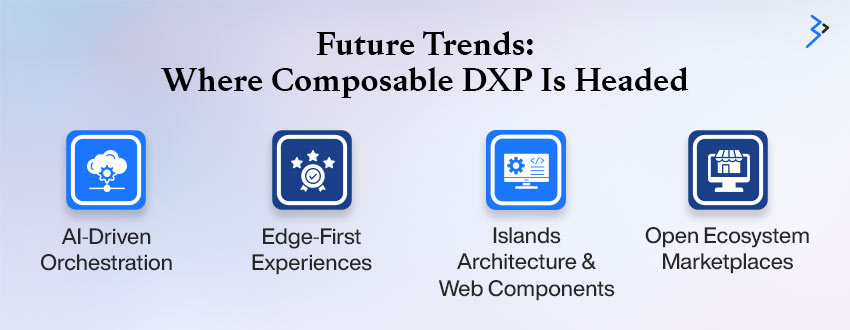
8.1 AI‐Driven Orchestration
AI will increasingly route content and service calls based on user context. Think generative personalization served in real time via composable microservices.
8.2 Edge‐First Experiences
Content and logic served at the edge—ultra-low latency for smart devices, APIs, and CX tools.
8.3 Islands Architecture & Web Components
Smaller islands of interactive UI load independently, reducing front-end bloat.
8.4 Open Ecosystem Marketplaces
Expect an exchange where pre-built Adobe-ready components (like pre-trained ML models, widgets) can easily plug into your stack.
Conclusion: Future‐Proof Your Digital Architecture
In an era of rapid change, composable DXPs are the blueprint for agility and innovation. Adobe’s ecosystem—spanning headless CMS, modular commerce, real-time data, personalization, and API orchestration—is uniquely positioned to support this paradigm.
By adopting a modular, API-driven architecture, brands can:
- React quickly to opportunities,
- Experiment often without risk,
- Keep digital experiences fast, personalized, and cohesive across channels.
Start small, build iteratively, govern wisely—then scale fast.
Take the First Step Today
- Schedule a Composable Audit: Evaluate Your Current Standing.
- Build a proof of concept: Try AEM headless for one digital touchpoint.
- Run an experiment: Add Adobe Target personalized content module into your POC.
- Share results: Highlight time-to-market improvements, performance wins, and conversions lift.
If you’re ready to launch your composable journey with Adobe, we’ve got you covered!
FAQs
A Composable DXP is a modular, API-first digital experience platform where each functionality, like content management, commerce, or personalization, is handled by independent services. Unlike monolithic DXPs, it allows faster innovation, flexible integrations, and agile deployments.
Adobe offers a powerful suite—AEM, Adobe Commerce, Target, Real-Time CDP, and Adobe Experience Platform—that is inherently modular and API-ready. These tools provide robust personalization, headless content delivery, and real-time data orchestration, which are essential for a composable architecture.
Yes, one of the main advantages of a composable approach is its ability to be adopted incrementally. You can begin with a headless CMS, then progressively decouple other services like personalization and commerce, ensuring minimal disruption and lower risk.
Composable DXPs enhance performance by allowing edge delivery, microservices, and lightweight frontends. Scalability improves because each component can be scaled independently based on demand, reducing bottlenecks and downtime.
Businesses that operate across multiple digital channels (e.g., retail, finance, real estate, and media) and need agility, personalization, and rapid innovation gain the most. It’s beneficial for enterprises with diverse customer touchpoints and a focus on user experience.
Initially, a composable architecture may seem costlier due to integrations and setup. However, over time, it often reduces the total cost of ownership (TCO) through modular upgrades, faster deployment cycles, and more efficient scaling.
Begin by auditing your current stack. Identify a core digital experience (like a website or app section) to transition using AEM’s headless capabilities. Then, integrate Adobe Target or CDP for personalization. Starting with a small pilot helps validate ROI before scaling.
Related Articles
-
Get to Market Faster and Sell Smarter with Adobe Commerce Cloud
The reality of running an online business in today’s modern world is the endless competition, the dynamic customer needs, and the constant need to be highly nimble. It used to
-
The Future of Unified Retail Commerce – Blending Online & In-Store with Adobe Experience Cloud
The retailing world is evolving. Gone are the days of a simple brick-and-mortar store or an e-commerce site. Customers of today do not view channels or see a brand. They
-
AI-Powered Personalization: Integrate Adobe Commerce with Real-Time CDP
Think about the last time you shopped online. Did the website feel like it “got” you, almost like it knew what you wanted before you even searched for it? It




